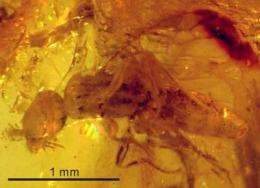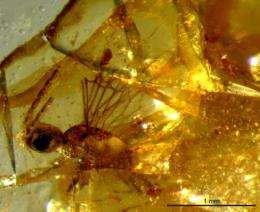New family of wasps found in North American amber, closest relatives in southern hemisphere

After being alerted by Alexandr Rasnitsyn (Palaeontological Institute of the Russian Academy of Sciences, Moscow) to two unusual wasps in amber found in New Jersey, USA, Denis Brothers (University of KwaZulu-Natal, South Africa) has determined that they represent a new family of wasps, but with its closest relatives found in South America and South Africa. The study was published in a special issue of the open-access journal ZooKeys dedicated to the 75th birthday of Professor Rasnitsyn.
The new family has been named Plumalexiidae, and comprises one new species, Plumalexius rasnitsyni Brothers, the names honouring Alexandr Rasnitsyn, who is undoubtedly the world's foremost authority on the diversity and fossil history of the Hymenoptera, the group of insects which comprises wasps, bees, ants, sawflies and their relatives, in commemoration of his 75th birthday.
The only known specimens are two small males found in Late Cretaceous amber from New Jersey, USA, dating from over 90 million years ago, which was apparently formed in a forested swampy environment. A detailed analysis during which they were compared with specimens of a variety of wasp groups, has shown that they are apparently most closely related to the family Plumariidae, now found only in the arid areas of South America and southern Africa and not known from any fossils. Although they share a few features with the Plumariidae, they also look very different, and so are considered best placed in a different family. The dissimilar habitats involved also indicate that their lifestyles and habits must have been different.

This finding raises many questions about the origins of the larger group of stinging wasps to which the new family belongs (the superfamily Chrysidoidea), the reasons for the apparently disjunct distributions of the grouping (Plumalexiidae in North America and Plumariidae in South America and southern Africa), and the biology of the new family (and even that of the Plumariidae, males and females of which have never been associated directly, and whose behaviour has not been observed in the field). These questions can only be answered satisfactorily once additional specimens, preferably from other localities, have been found.
More information: Brothers DJ (2011) A new Late Cretaceous family of Hymenoptera, and phylogeny of the Plumariidae and Chrysidoidea (Aculeata). In: Shcherbakov DE, Engel MS, Sharkey MJ (Eds) Advances in the Systematics of Fossil and Modern Insects: Honouring Alexandr Rasnitsyn. ZooKeys 130: 515. doi: 10.3897/zookeys.130.1591
Provided by Pensoft Publishers


















